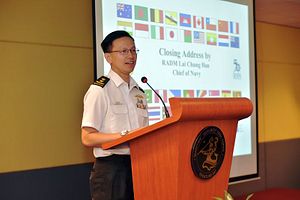Since the enacting of the Code for Unplanned Encounters at Sea (CUES) – a series of naval protocols for the safety of naval vessels enacted at the Western Pacific Naval Symposium back in 2014 – key Asian countries have begun testing it in their exercises with each other while others have considered expanding it as well.
The more well-known line of effort at expansion is the proposal advanced by several countries, including Singapore, Malaysia, and the United States, of having CUES cover disputed areas – including parts of the South China Sea – and non-military vessels like coast guards (See: “Malaysia Wants Expanded Naval Protocol Amid South China Sea Disputes”).
As I have noted before, that would seem prudent, especially given the fact that confrontations in the South China Sea have often involved non-military vessels, including large Chinese coast guard ships and smaller ones manned by militia organized by Beijing.
Less well-known, but equally important, is the attempt to broaden CUES to the undersea domain. Singapore in particular has been leaning the effort to push through what has been called the Underwater Code for Unplanned Encounters at Sea (UCUES).
The logic for UCUES is clear. As Singaporean defense officials have rightly and repeatedly cautioned, given the busyness and shallowness of some of Asia’s waters as well as the rapid rise of submarines expected in the region over the next few years, there is a need to enhance submarine operational safety and boost multilateral submarine rescue cooperation (See: “A New Plan to Manage Asia’s Submarine Race?”). One way to accomplish this is to develop some common rules of the road for the undersea domain.
Where is UCUES now? The first draft of UCUES was officially introduced at the 2nd Submarine Operational Safety Conference (SMOSC) which ran from May 29 to June 2 last year and was chaired by the RSN and the Republic of Korea Navy (ROKN). The draft details a set of non-binding safety procedures designed to prevent collisions, including basic maneuvering instructions derived from existing manuals or accepted practices.
This was part of a broader effort to get inputs from interested navies as it is being developed. As might be expected, there have been reservations expressed by some states, including in sharing information that they would otherwise prefer to keep secret.
During his speech last week at the closing of the maritime information-sharing exercises held at Changi Command and Control Center in conjunction with the RSN’s 50th anniversary, Singapore’s navy chief Lai Chung Han mentioned UCUES once again.
He also attempted to allay some of these concerns as the proposal continues to be floated, emphasizing that UCUES does not represent waterspace management, which he admitted would be “a great faux pas” for sensitive submarine operations, but sharing unclassified information that might be useful. Whether such clarifications can alleviate lingering anxieties among concerned states, though, remains to be seen.

































